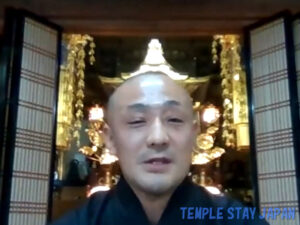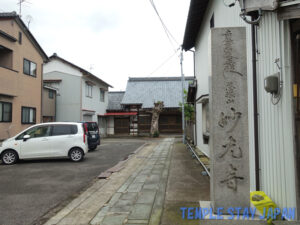Introduction to Eiheiji Temple
Eiheiji is a temple founded in 1244 by Zen Master Dogen, the founder of the Soto sect. Many buildings, including the main gate, main hall, and Buddha hall, have been designated as Important Cultural Properties.
It is the head temple of the Soto sect of Zen Buddhism, and even today many monks from all over Japan gather here to practice Zen.
Shukubo (temple stay)
Hakujukan is a lodging facility at Eiheiji Temple. The first thing that caught my eye at the entrance was a fish-shaped drum called “Hou”. It was originally used at Eiheiji Temple and was rung to signal meal times.
The guest rooms are named after flowers, and the one I stayed in was called “Hanasyobu” (It means iris).
The interior is a combination of Japanese-style and Western-style rooms, with two beds side-by-side. Equipped with a toilet, washbasin, bath, safe and refrigerator. Towels, bath towels, toothbrushes, razors, combs, cotton, cotton swabs, work clothes, and socks are provided.
Many local crafts are featured. There was Echizen washi wallpaper, Echizen ware washbasins, Echizen lacquerware room tags, Echizen ware teapots and teacups, and more.
Zen meditation and Copying sutrasThe Zen meditation session began at 3:30 p.m. We were given instructions on how to sit, and then we did zen meditation.
We borrowed tools from the front desk and did the copying sutras in our room.
Buddhist vegetarian cuisine
At Hakujukan, we could choose between vegetarian cuisine and local cuisine, so we chose the vegetarian cuisine. The head chef learned how to make the food from a monk at Eiheiji Temple, and Buddhist teachings are incorporated into the menu.
The flavor of sesame tofu, a staple of buddhist vegetarian cuisine, spread throughout the mouth. This imitation eel, which was created without using meat or fish, is very fragrant. The Hiryozu, which is wrapped with vegetable pieces to avoid wasting ingredients, was also delicious.
Local ingredients were also used, and the rice was “Ichihomare” from Fukui Prefecture. In addition, there is a large selection of local Fukui sake available, which must be ordered separately.
Morning service
The next morning, I attended the service at Eiheiji Temple. We gathered in the lobby at 4:50 and were guided there by the staff at the shukubo (Times vary depending on the season).
After entering the main hall and waiting for a while, more than 100 monks entered the hall. The sounds of bells and drums echoing and the sonorous chanting of sutras is a spectacular sight.
We walked through the middle to the main image of Kannon (Avalokitesvara), where we were able to offer incense. The names of the guests were read out, and I joined my hands in prayer for the health of their families.
After the service was over, a staff member showed us around the grounds. At Eiheiji, the temple’s main hall, buddhist hall, main gate, and other buildings are lined up along the mountain slope. She explained to us in an easy-to-understand way about the highlights of each temple and the life of the monks.
Porridge breakfast
After walking around Eiheiji for about an hour, we returned to Hakujukan for breakfast. The food consisted mainly of porridge, but there was a wide variety of dishes, making it a very filling morning meal.
Check-out is at 10am. I left my luggage there and visited Eiheiji Temple once again. The premises are so large that we couldn’t see everything on our early morning guided tour, so we were able to take our time looking around.
Booking Link
Eiheiji-Hakujukan official website



